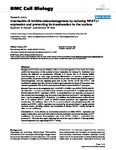Interleukin-10 inhibits osteoclastogenesis by reducing NFATc1 expression and preventing its translocation to the nucleus
| dc.contributor.author | Evans, KE | |
| dc.contributor.author | Fox, Simon | |
| dc.date.accessioned | 2018-08-13T13:14:23Z | |
| dc.date.available | 2018-08-13T13:14:23Z | |
| dc.date.issued | 2007-12 | |
| dc.identifier.issn | 1471-2121 | |
| dc.identifier.issn | 1471-2121 | |
| dc.identifier.other | 4 | |
| dc.identifier.uri | http://hdl.handle.net/10026.1/12054 | |
| dc.description.abstract |
BACKGROUND: IL-10 has a potent inhibitory effect on osteoclastogenesis. In vitro and in vivo studies confirm the importance of this cytokine in bone metabolism, for instance IL-10-deficient mice develop the hallmarks of osteoporosis. Although it is known that IL-10 directly inhibits osteoclastogenesis at an early stage, preventing differentiation of osteoclast progenitors to preosteoclasts, the precise mechanism of its action is not yet clear. Several major pathways regulate osteoclastogenesis, with key signalling genes such as p38, TRAF6, NF-kappaB and NFATc1 well established as playing vital roles. We have looked at gene expression in eleven of these genes using real-time quantitative PCR on RNA extracted from RANKL-treated RAW264.7 monocytes. RESULTS: There was no downregulation by IL-10 of DAP12, FcgammaRIIB, c-jun, RANK, TRAF6, p38, NF-kappaB, Gab2, Pim-1, or c-Fos at the mRNA level. However, we found that IL-10 significantly reduces RANKL-induced NFATc1 expression. NFATc1 is transcribed from two alternative promoters in Mus musculus and, interestingly, only the variant transcribed from promoter P1 and beginning with exon 1 was downregulated by IL-10 (isoform 1). In addition, immunofluorescence studies showed that IL-10 reduces NFATc1 levels in RANKL-treated precursors and suppresses nuclear translocation. The inhibitory effect of IL-10 on tartrate-resistant acid phosphatase-positive cell number and NFATc1 mRNA expression was reversed by the protein kinase C agonist phorbol myristate acetate, providing evidence that interleukin-10 disrupts NFATc1 activity through its effect on Ca2+ mobilisation. CONCLUSION: IL-10 acts directly on mononuclear precursors to inhibit NFATc1 expression and nuclear translocation, and we provide evidence that the mechanism may involve disruption of Ca2+ mobilisation. We detected downregulation only of the NFATc1 isoform 1 transcribed from promoter P1. This is the first report indicating that one of the ways in which IL-10 directly inhibits osteoclastogenesis is by suppressing NFATc1 activity. | |
| dc.format.extent | 4- | |
| dc.format.medium | Electronic | |
| dc.language | en | |
| dc.language.iso | eng | |
| dc.publisher | Springer Science and Business Media LLC | |
| dc.subject | Animals | |
| dc.subject | Calcium | |
| dc.subject | Carcinogens | |
| dc.subject | Cell Differentiation | |
| dc.subject | Cell Line | |
| dc.subject | Cell Nucleus | |
| dc.subject | Gene Expression Regulation | |
| dc.subject | Interleukin-10 | |
| dc.subject | Mice | |
| dc.subject | NFATC Transcription Factors | |
| dc.subject | Osteoclasts | |
| dc.subject | Protein Transport | |
| dc.subject | RNA, Messenger | |
| dc.subject | Tetradecanoylphorbol Acetate | |
| dc.title | Interleukin-10 inhibits osteoclastogenesis by reducing NFATc1 expression and preventing its translocation to the nucleus | |
| dc.type | journal-article | |
| dc.type | Journal Article | |
| dc.type | Research Support, Non-U.S. Gov't | |
| plymouth.author-url | https://www.webofscience.com/api/gateway?GWVersion=2&SrcApp=PARTNER_APP&SrcAuth=LinksAMR&KeyUT=WOS:000244017100001&DestLinkType=FullRecord&DestApp=ALL_WOS&UsrCustomerID=11bb513d99f797142bcfeffcc58ea008 | |
| plymouth.issue | 1 | |
| plymouth.volume | 8 | |
| plymouth.publication-status | Published | |
| plymouth.journal | BMC Cell Biology | |
| dc.identifier.doi | 10.1186/1471-2121-8-4 | |
| plymouth.organisational-group | /Plymouth | |
| plymouth.organisational-group | /Plymouth/Faculty of Health | |
| plymouth.organisational-group | /Plymouth/Faculty of Health/School of Biomedical Sciences | |
| plymouth.organisational-group | /Plymouth/Research Groups | |
| plymouth.organisational-group | /Plymouth/Research Groups/Institute of Translational and Stratified Medicine (ITSMED) | |
| plymouth.organisational-group | /Plymouth/Research Groups/Institute of Translational and Stratified Medicine (ITSMED)/CBR | |
| plymouth.organisational-group | /Plymouth/Research Groups/Plymouth Institute of Health and Care Research (PIHR) | |
| plymouth.organisational-group | /Plymouth/Users by role | |
| plymouth.organisational-group | /Plymouth/Users by role/Academics | |
| dc.publisher.place | England | |
| dcterms.dateAccepted | 2007-01-19 | |
| dc.identifier.eissn | 1471-2121 | |
| dc.rights.embargoperiod | Not known | |
| rioxxterms.funder | Wellcome Trust | |
| rioxxterms.identifier.project | Analysis of the signalling mechanism by which TGF-B determines osteoclast/macrophage lineage-switching. | |
| rioxxterms.versionofrecord | 10.1186/1471-2121-8-4 | |
| rioxxterms.licenseref.uri | http://www.rioxx.net/licenses/all-rights-reserved | |
| rioxxterms.licenseref.startdate | 2007-01-19 | |
| rioxxterms.type | Journal Article/Review | |
| plymouth.funder | Analysis of the signalling mechanism by which TGF-B determines osteoclast/macrophage lineage-switching.::Wellcome Trust |


